Pam Hawley Marlin May 2019
The Grand Opera House in Garnett, Kansas, played host to a variety of events in the late nineteenth century - dances, shows, lectures, and plays. None of these events, however, would prove as exciting or as suspenseful as the séance performed by Harry Houdini on the night of November 26, 1897. The old gas lamps warmed the atmosphere of the Grand Opera House that night, providing the perfect setting for Harry Houdini's "sensational spiritualistic performance."
In 1897 Harry Houdini and his young wife, Bess, performed mind-reading routines, escape acts, and illusions with a traveling medicine show called Dr. Hill’s California Concert Company. Joe and Myra Keaton, parents of Buster Keaton, were also part of the traveling show for a time (Joe and Myra became close friends with Bess and Harry Houdini as they traveled together with the show). The traveling show's entertainment consisted of a "basic roster of mildly risque song-and-dance men, implausibly buxom, bloomer-clad strongwomen, and pathetically deformed children, usually interspered with some amusingly prehensile monkeys. At intervals, the fast-talking Dr. Hill himself, would take the stage to promote the benefits of patent remedies like his Mokeena ("the Mokeena you drink, the Mokeena you feel") which generally consisted of heavily sugared water with a few added drops of dynamite-strength whiskey." 1
 The Houdinis (1895).
Library of Congress
The Houdinis (1895).
Library of Congress
During this time, Houdini began to experiment with spirit medium’s tricks. He performed séances while his wife, Bess, acted as a clairvoyant claiming to have psychic gifts. To prepare for these acts, Harry and Bess would do their research prior to performing the show. When they arrived in a new town, the couple read obituaries and visited graveyards to learn the names of those who had recently died. This research was important in convincing audiences of their spiritualistic abilities.
Dr. Hill’s California Concert Company medicine show arrived in Garnett in November 1897. Houdini did not travel light, "in addition to his and Bess's personal effects, he carried an assortment of props that even in the late 1890's was sufficient to fill nine steamer trunks and two large hampers."1 Houdini joked later that he never left the house "without forty pieces of luggage." 1 The following account of Houdini's arrival in Garnett was printed in the Garnett Plain-Dealer on October 24, 1935.
"In 1897, Harry Houdini was a member of a troupe as was his wife. They were put up at the rooming house of Mrs. Bennett, situation at it's present location. Mrs. John Barley, Bayard, KS (then Hallie Nichols) tells the following:
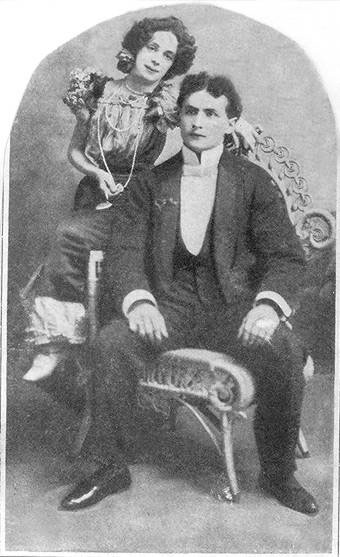 Bess and Harry Houdini in 1899.
Bess and Harry Houdini in 1899.
In Autumn of 1897, after a disastrous engagement at Milwaukee, the manager swindled them out of their salary. Dr. Hill's traveling medicine show, known as California Concert Co., offered Houdini $25 a week. The Houdini's scraped together enough money for fares to Garnett, where the show was playing. They changed cars at 3 A.M. and no one was available to shift the trunks and the train was ready to leave. They got two of the four trunks into the baggage car, and the conductor insisted on pulling out. Houdini was to start that day for a fifteen week engagement. The conductor pushed Houdini aside and waved for the engineer to start. Houdinin sprinted past the locomative and laid face down across the track.
Two brakemen seized him around the waist, but could not budget him. He had his fingers dug about one rail and his toes club to the other. His muscles were like iron and he knew the stiffening truck so that the train men could not move him. Finally the engineer told him "his damned trunks were on board." Houdini reached the show on time - with his trunks."
The Public Square in Garnett was the hub of activity in the 1890's. General stores, newspaper offices, administrative offices, restaurants, and the opera house surrounded the Anderson County courthouse. When the California Concert Company traveling show performers assembled in Garnett, Drs. Thomas Hill and Perry K. Pratt worked the medicine show in the Public Square. Dr. Pratt, a white haired gentleman, played a small organ while Houdini played the tambourine. The Company's dancers, singers and magicians also performed. As the crowds grew, Drs. Hill and Pratt launched into the benefits of their wonderful medicine. The performers then moved through the crowd, collecting money and handing out medicine bottles.
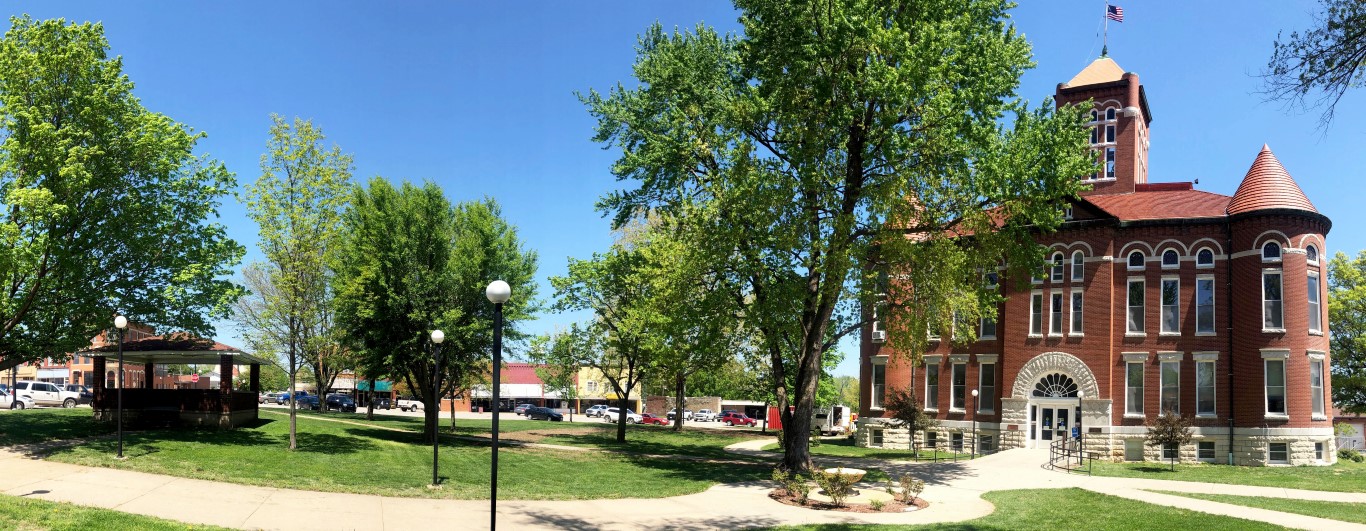 Garnett Public Square in 2019. P Marlin
Garnett Public Square in 2019. P Marlin
As part of the show's performance, Houdini impressed the crowds in the square with his coin and card tricks. He also amazed the councilmen with his ability to find hidden items hidden around the town. His most exciting performance, however, was escaping from the local jail, also located in the Public Square, after Sheriff Park Keeney locked him in. 4
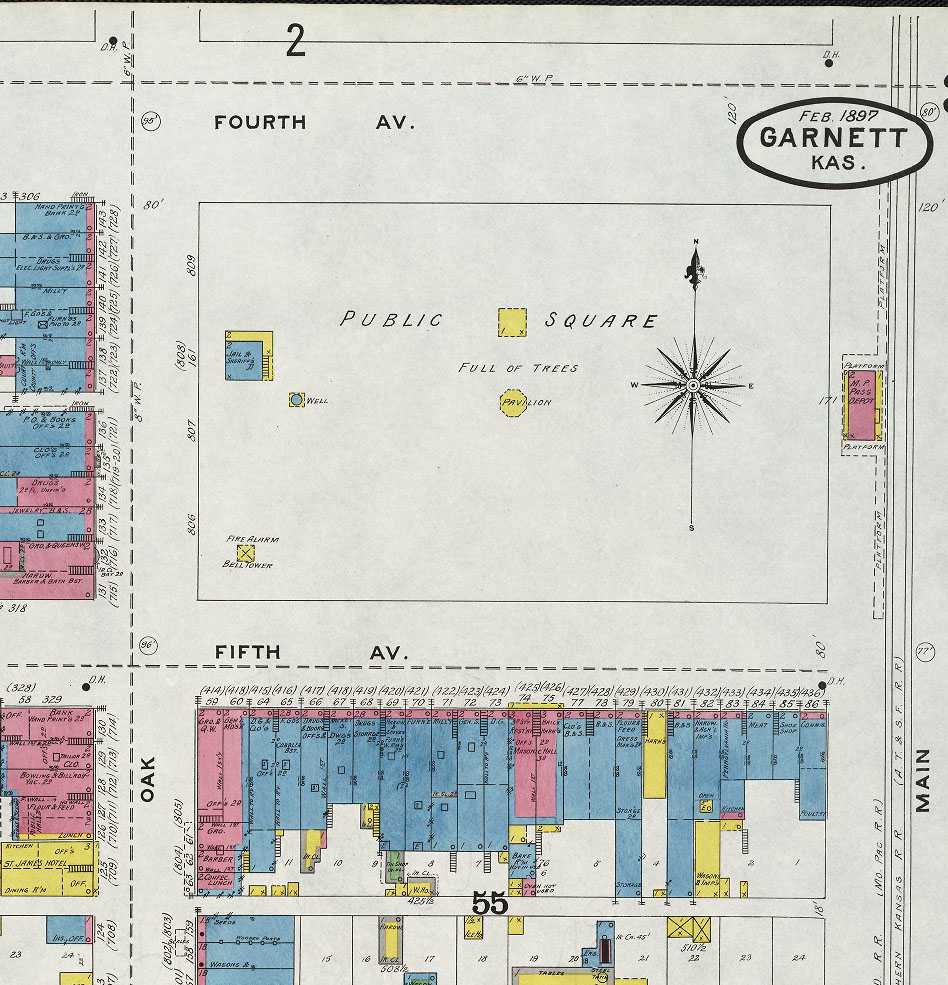 Garnett Public Square in 1897. The Grand Opera House
(not visible on this map) was located in the upper corner of the map
and the jailhouse (the small blue and yellow box) was located within
the public square. Sanborn Maps via University of Kansas Maps.
Garnett Public Square in 1897. The Grand Opera House
(not visible on this map) was located in the upper corner of the map
and the jailhouse (the small blue and yellow box) was located within
the public square. Sanborn Maps via University of Kansas Maps.
 Garnett Public Square (1900-1920) with the Grand
Opera House visible to the right of the gazebo. Bess Houdini
recalled taking one-year old Buster
Keaton to the Public Square Park in Garnett in the
afternoons while his parents, Joe and Myra,
were rehearsing.2
Photo Source: Kansas Memory
Garnett Public Square (1900-1920) with the Grand
Opera House visible to the right of the gazebo. Bess Houdini
recalled taking one-year old Buster
Keaton to the Public Square Park in Garnett in the
afternoons while his parents, Joe and Myra,
were rehearsing.2
Photo Source: Kansas Memory
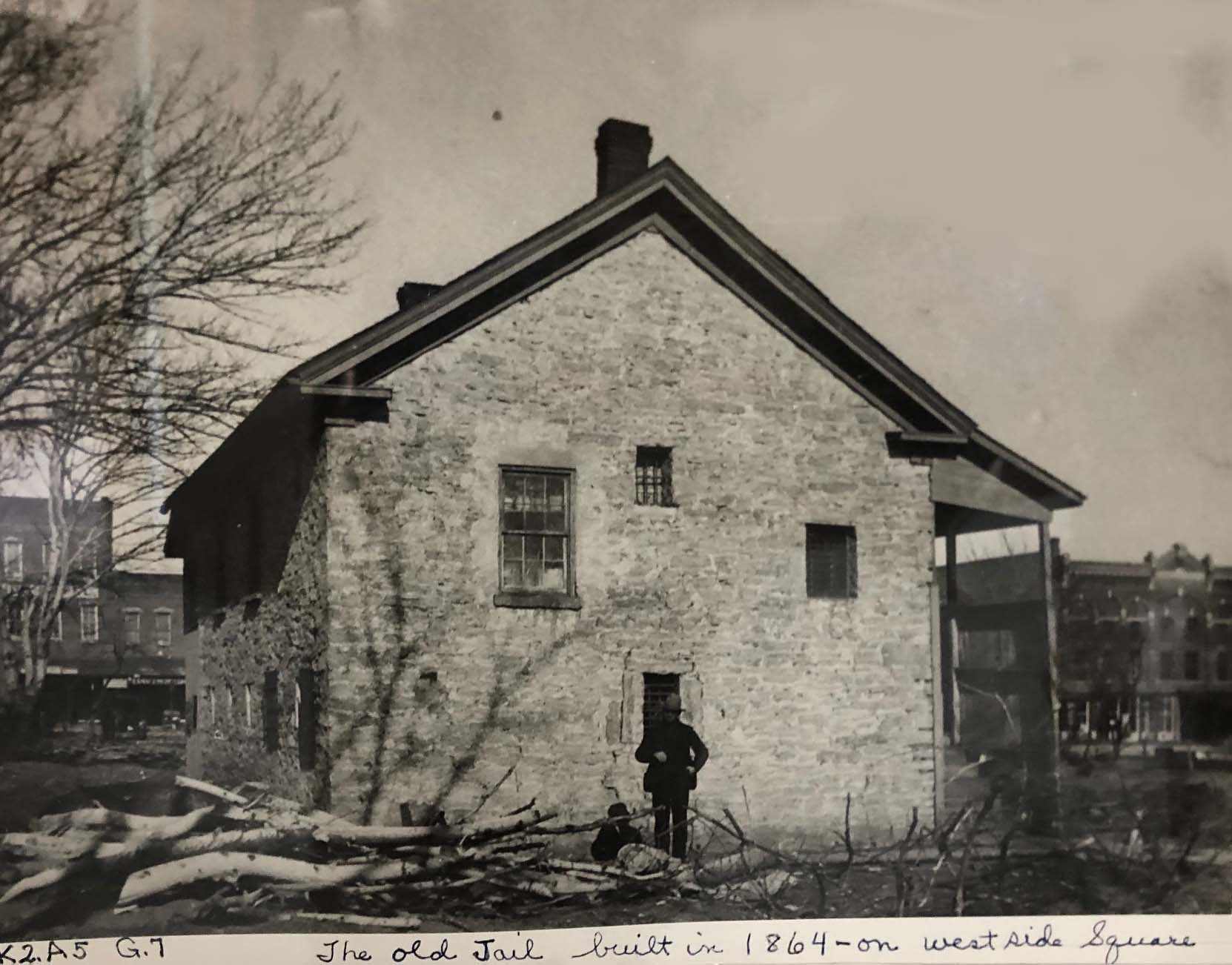 Garnett jail in the Public Square (built 1864 - now gone).
Performing one of his tricks, Houdini was said to have broke out of
the jail after Sheriff Keeney locked him in. The Grand Opera House
is visible in the distance to the right of the jail. Anderson County Historical Museum.
Garnett jail in the Public Square (built 1864 - now gone).
Performing one of his tricks, Houdini was said to have broke out of
the jail after Sheriff Keeney locked him in. The Grand Opera House
is visible in the distance to the right of the jail. Anderson County Historical Museum.
At the close of the daily medicine show in the Public Square, Dr. Hill announced a "great show that the performers were to present that evening, for "trifling admission" of ten, fifteen and twenty-five cents.” The great show would be performed at one the largest buildings on the square, the Grand Opera House. Built in 1884, the Grand Opera House still used gas lights.
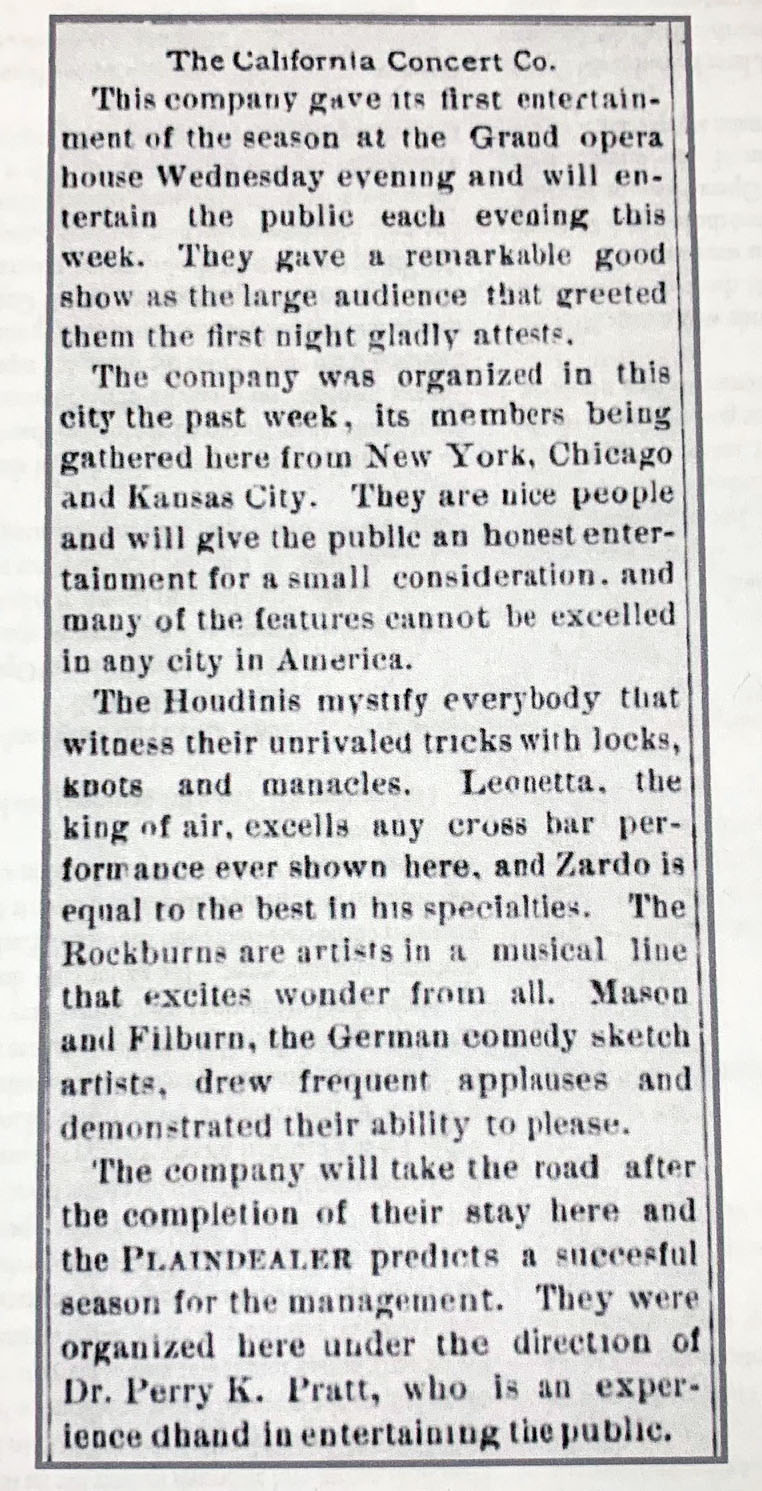 The Garnett Plain-Dealer and Anderson County Republican
Friday, November 19, 1897.
The Garnett Plain-Dealer and Anderson County Republican
Friday, November 19, 1897.
 The Grand Opera House. Anderson County Historical Museum.
The Grand Opera House. Anderson County Historical Museum.
 Early performers at the Grand Opera House (1885). Anderson County
Historical Museum.
Early performers at the Grand Opera House (1885). Anderson County
Historical Museum.
 The Grand Opera House and the buildings located along the
north side of the Public Square.
The Grand Opera House and the buildings located along the
north side of the Public Square.
 My Hawley family lived in Garnett, Kansas for nearly a century. This
photo is of my 3rd great uncle, Jay Hawley’s, car which broke down
near the front of the Grand Opera House.
My Hawley family lived in Garnett, Kansas for nearly a century. This
photo is of my 3rd great uncle, Jay Hawley’s, car which broke down
near the front of the Grand Opera House.
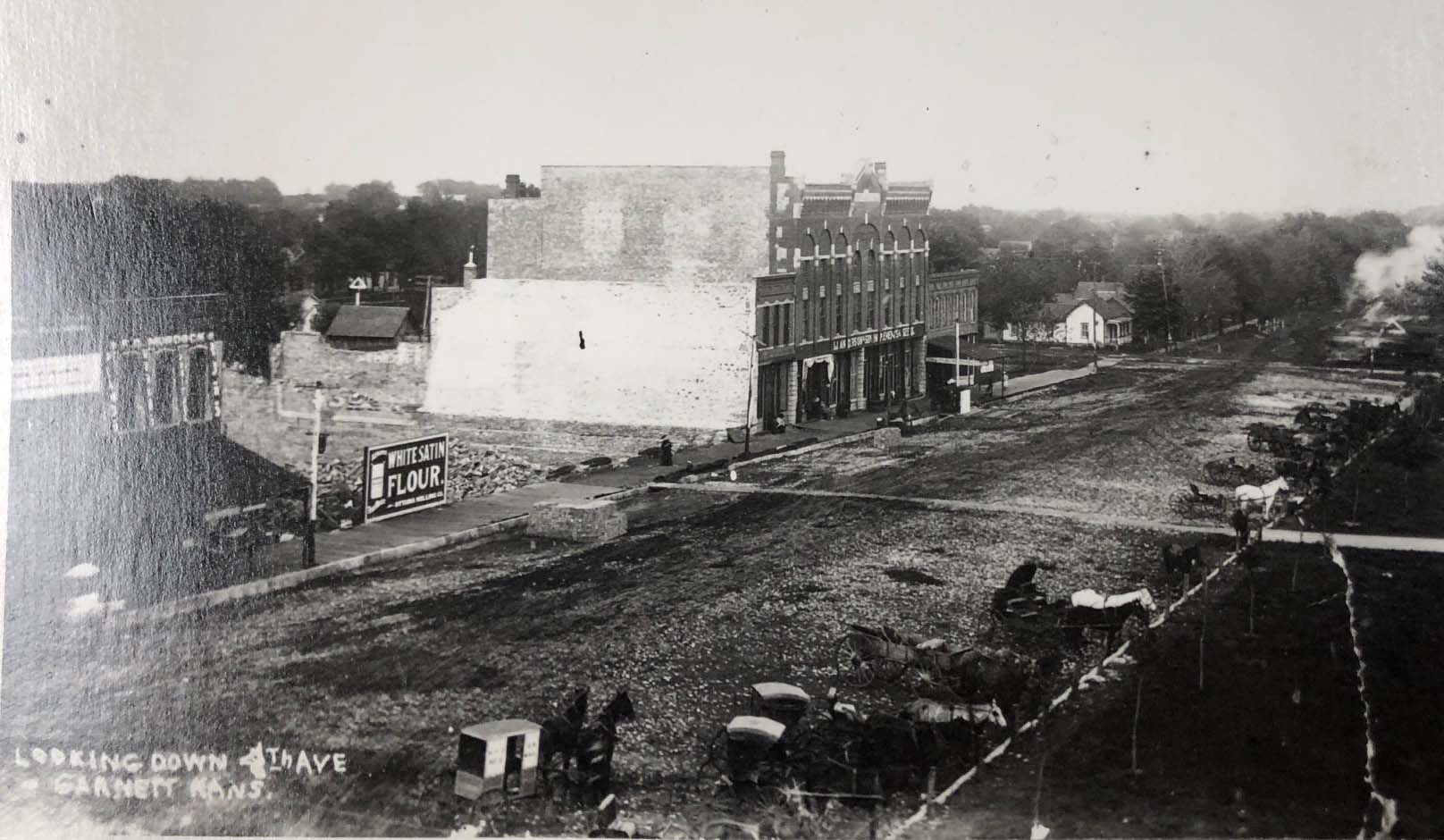 The Garnett Opera House and 4th Avenue.
Anderson County Historical Museum.
The Garnett Opera House and 4th Avenue.
Anderson County Historical Museum.
 Garnett Opera House, 1897. Sanborn Maps via
University of Kansas Maps.
Garnett Opera House, 1897. Sanborn Maps via
University of Kansas Maps.
When the California Concert Company show arrived in Garnett in November, a local resident’s recent murder had not yet been solved. A certain fear still hung in air as the local townspeople were aware that the murderer had not been caught. The situation created the perfect environment for Houdini to perform the most "sensational spiritualistic performance" ever. Houdini learned of the murder while researching local stories for the show.
Nearly a month prior to the arrival traveling show's arrival in Garnett, a local resident, Mrs. Isaac (Anna) Paul, was found murdered in her home. It was a particularly brutal murder as told in the Kansas Agitator on Friday, October 15, 1897:
"Just as we were preparing to go to press, today, at noon, the news was brought to town, by a boy on horseback, that Mrs. Isaac Paul, living about five miles east of Garnett, had been murdered. Sheriff Keeney and a posse of men were soon on their way to the scene of the murder. Carriages and wagons filled with men, men on horses, and bicycles - nearly all armed, and wild with excitement - hurried after.
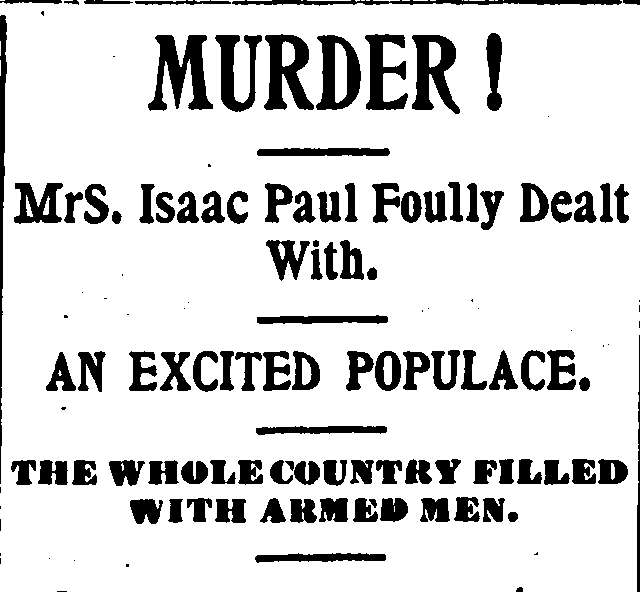 The Kansas Agitator article on Friday, October 15, 1897.
The Kansas Agitator article on Friday, October 15, 1897.
Mr. Paul (Mrs. Paul's husband) had been gathering apples near the house during the forenoon. A little before noon, he thought he would water his horses, and by that time dinner would be ready. However, something impelled to go to the house first, and there a terrible sight met his gaze - his wife reclined against a bed, not yet dead, but unconscious, a wound in her forehead and her head cut open across the top. Everything about the house was topsy-turvy, and there were evidences of a struggle. Judging from the indications, the object of the person or persons who committed the deed was robbery.
There was a double barreled shotgun in the room, loaded, and, from the indications, Mrs. Paul had grabbed the gun and snapped both caps, but the gun failed to "go off." It appears the murderer took the gun from her and struck her on the forehead. This failing to kill her, he cut her head open with something - possibly a corn knife. Then (from appearances) he went through the house in search of money."
On October 26, the nephew of Mrs. Isaac (Anna) Paul, Steve Paul, was arrested for her murder by Garnett Sheriff, Park Keeney. At the time of arrest, Steve had been working at the farm of John McCormick at Raymond in Rice County. Steve was brought before Judge T. H. Harder who set an Examination date to review the evidence for November 5, 1897. Steve was held in the Allen County jail until the examination date.
At the November 5 Examination County Attorney Clark T. Richardson and Defense Attorney W.O. Knight presented evidence as to the whereabouts of Steve Paul on the day of the murder. At the conclusion of the Examination, it was determined by Judge Harder that the accused, Steve Paul, was in Rice County on October 15 and therefore could not have committed the offense charged.
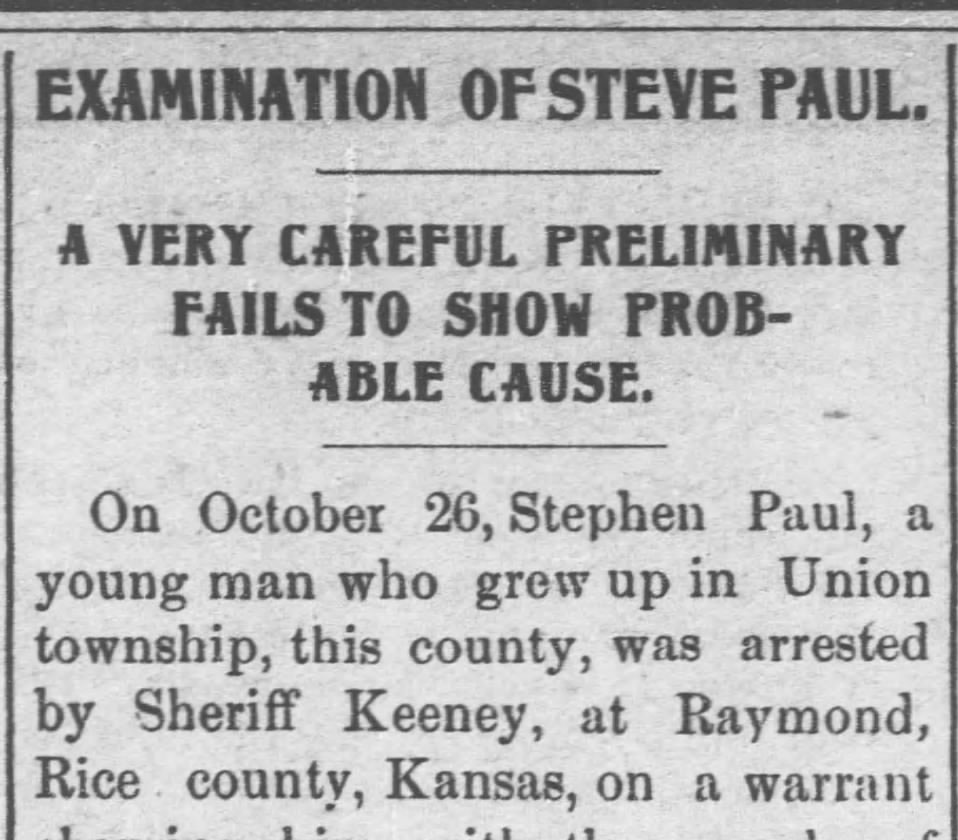 The Garnett Journal account of
the examination with depositions from Friday, November 19, 1897.
The Garnett Journal account of
the examination with depositions from Friday, November 19, 1897.
The California Company continually looked for ways to increase their income. It was suggested by Dr. Hill or Houdini himself, that Houdini should perform a “séance” at the Company’s evening show. It was thought that a spiritualistic encounter would boost the show’s audience and earnings.
As the Company performed around the Public Square, Houdini announced that he would perform a séance at the Grand Opera House on the evening of November 26 .... and at the séance, he would reveal the identity of the person who murdered Mrs. Isaac (Anna) Paul. The recent murder was still on everyone's mind, so the news of the upcoming séance spread quickly through town. The townspeople became anxious and excited, this was a performance they could not miss!
 The traveling medicine show members.
The traveling medicine show members.
As the evening's séance time grew near, Houdini began his research. He, the sexton, and the "oldest inhabitant" in town, walked to the Garnett cemetery. As he went grave by grave with notebook in hand, Houdini made notes on "everyone sleeping in God's acre." Any information on the townspeople that was not engraved on the "slabs of marble or granite tombstones" in the cemetery, was shared by the sexton and "old Uncle Rufus." 3
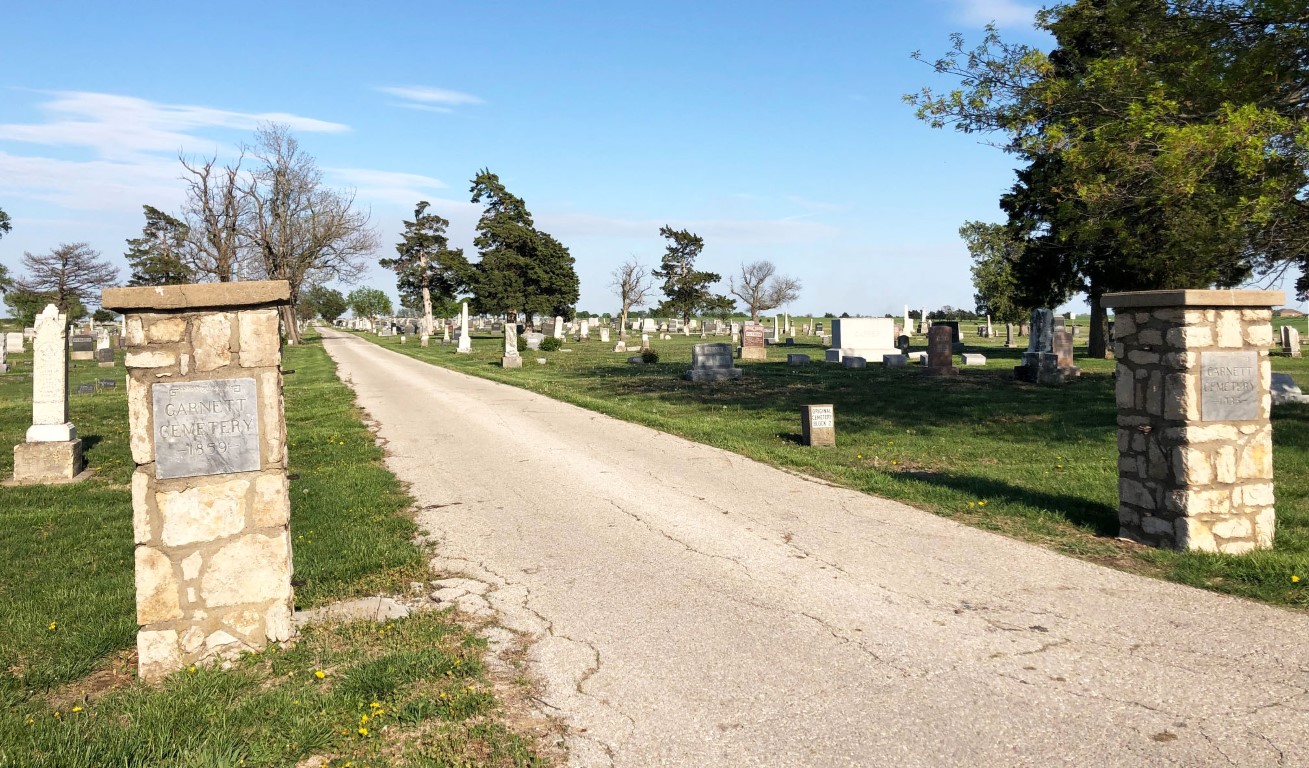 The Garnett Cemetery entrance in 2019. P. Marlin
The Garnett Cemetery entrance in 2019. P. Marlin
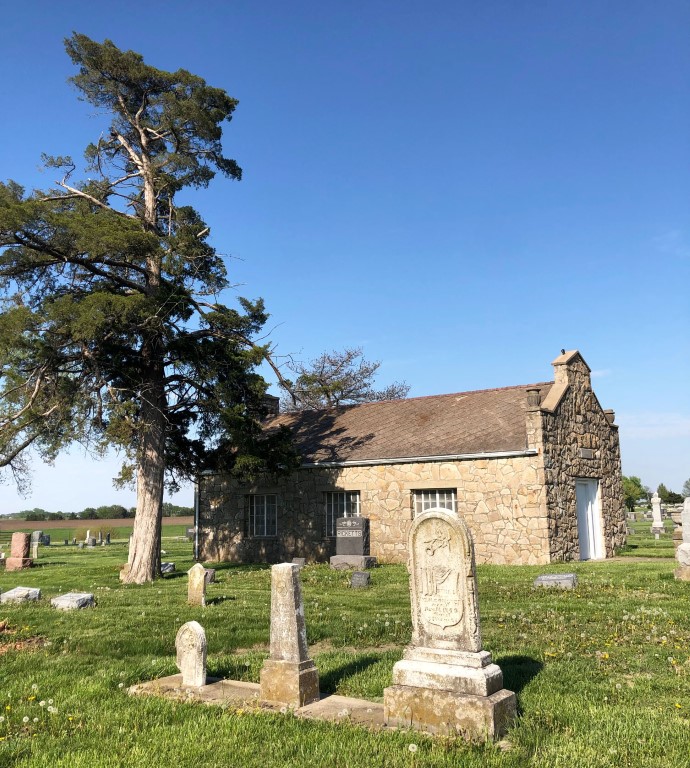 The Garnett Cemetery in 2019. P. Marlin
The Garnett Cemetery in 2019. P. Marlin
The California Company's performance on the night of November 26, 1897 was the largest audience to attend an event at the Grand Opera House.

The following description of the séance is described in excerpts from the books Masters of Mystery and The Secret Life of Houdini:
"The lights were low, the music soft as the audience settled into their seats in the largest building Garnett, Kansas, that cold Sunday night in November 1897. They were there to see a traveling variety show whose star attraction the local Evening Review had hailed as "the World Famous Medium." 1
As the séance began, Houdini, in dramatic fashion, revealed the information he had gleaned from local gossip and his research trip to the town cemetery.
"Harry Houdini did not disappoint them. Bounding on stage, the wiry, tousel-haired twenty-three-year-old, dressed in ill-fitting tails, was able both to produce the promised psychic phenomena, including the news that one well-known businessman who was present was "cruelly neglecting to tend his own mother's grave" despite enjoying "many merry excursions with (his) lovely secretary." 1
Houdini went on to state that a young mother who was in the theater was undoubtedly thinking of her deceased baby Louise," whom the Lord has been pleased to call at an early age." Shielding his eyes as though squinting into the heavens, he added that "Louise and many others are here with us tonight." 1
AUTHOR'S NOTE: the REAL name of the murdered woman was Mrs. Isaac (Anna) Paul, however, the name was changed to Sadie Timmons in various print publications and thus used in this blog's references.
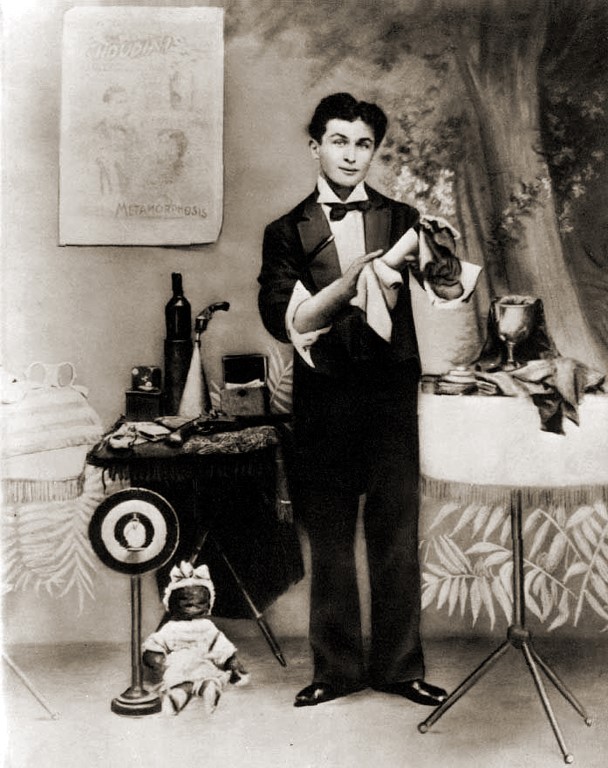 Houdini in 1896.
Houdini in 1896.
As the séance continued, Houdini stated that he would end the performance by revealing the identity of the murderer of Sadie Timmons (Mrs. Anna Paul), "We propose to contact our friends and ancestors on the other side." he said. "You cannot hide a nefarious deed from the spirits, and Mademoiselle Beatrice, a trained psychometric clairvoyant, will assist me." 1
"WE HAVE JUST RECENTLY BECOME AWARE of a tragic situation in this good town of Garnett, Kansas,” the Great Houdini said...." 4
"The audience, which had filled the old opera house to the rafters that November night in 1897, held its breath. This was what they had been waiting for all night. Houdini, who along with his wife who had the power, was going to reveal just who had killed Sadie Timmins. Sadie’s murder had been brutal, they knew that much. Sheriff Keeney had scoured the hills and the hollows of town for the murderer—to no avail. Now this outsider, this charismatic wonder-worker was going to contact the spirit world and get the inside dope. Well, maybe he could, the townsfolk thought. After all, he had already escaped from the old stone jail just minutes after the sheriff had locked him in there, and he was able to find all those items that had been hidden around town by the councilmen, while he was blindfolded. So naming an unknown killer might be a cakewalk for the likes of him. “A lovely young lady, Miss Sadie Timmins, was discovered brutally murdered,” Houdini said. “Now, the sheriff, Mr. Keeney, is a good and a great man, and he has done everything that is earthly possible to bring the killer to justice.” A buzz went through the crowd. Not everyone there believed that Sheriff Keeney was, in fact, so diligent. “Earthly possible. We propose to contact the spirit world, our ancestors who lovingly and with great concern watch over our every movement on this sphere. You cannot hide a nefarious deed from the spirits!” Houdini thundered." 4
Houdini queued the music and the orchestra began to play "Nearer My God to Thee."4 As the audience hummed the tune, Mademoiselle Beatrice (Houdini's wife, Bess) entered the stage. Bess groaned and slumped in her chair. Houdini announced, "She is in a trance state." At this point, Houdini began to ply Bess with questions about the murder. The excitement continued to build to a fever pitch in the Opera House as the drama filled performance continued to unfold.
“Was Sadie Timmons murdered on her property?” he began.
“Yes,” Bess answered in a quavering voice.
“Can you tell us where?”
“In her kitchen,” Bess replied.
“Was the killer an intruder?”
“No.”
"So he was known to her?” Houdini stopped dramatically.
“Yes.”
“Can you describe the killer for us?” Houdini asked.
Bess began to breathe rapidly. “He’s tall. With a black moustache and goatee.”
"What is his name?" Houdini asked.
"Quick. Answer. What is his name?" Houdini persisted.
“His name is… is… is…” Suddenly Bess threw up both arms and, with a sickening cry, slumped back into her chair.
“Is there a doctor in the house? My wife has fainted!” declared Houdini. 4
The sensational séance ended. The women in the audience were upset, men were arguing, and the sheriff was surrounded by an angry crowd. After Bess fainted, the murderer's identity would not be revealed, however, the California Concert Company had sufficient funds to pay for their rooms that night and continue on with their Kansas tour. The séance was so popular, it became a regular part of Dr. Hill's show into 1898.4

Twenty-six years later, Ms. Hallie Nichols, a local Garnett resident who had been in the Grand Opera House that November 1897 night, went to see Houdini give a lecture on Spiritualism in Kansas City. Ms. Nichols sent a note to Houdini that she had been in his audience in Garnett years earlier, to which Houdini asked Ms. Nichols to come backstage after the lecture to dine with him and his wife, Bess.
As they dined with Ms. Nichols, Houdini recalled the séance and his visit to the Garnett cemetery where he saw the fresh grave of six-year-old Joe Osbourne. Houdini had decided to use the story of "little Joe" in his séance that evening.
The following is an excerpt from the book, Final Séance: The Strange Friendship Between Houdini and Conan Doyle which describes the meeting of Ms. Nichols and Houdini
"At the next séance in Garnett, which broke the record for admissions at the opera house, Bess was in a trance when she suddenly said she had a message from “little Joe” for his parents. Someone rushed out and brought back a white-faced Mr. and Mrs. Harry Osbourne. “Joe says he’s in a happy place. And he says, ‘Don’t cry, Momma. There’ll be another one soon to take my place,’” Bess relayed.
The fact was Mrs. Osbourne was pregnant, a shrewd guess by Houdini since they were a young, grief-stricken couple. After the séance, an irate Harry Osbourne came backstage to give Houdini a thrashing. “How could we know of your family circumstances if the medium was not clairvoyant?” Houdini asked him. Then he had Bess rattle off a number of other family secrets that had Osborne mystified as he left the opera house.
This incident made an indelible mark on Houdini and he asked her [Ms. Nichols] if she was still in contact with the Osbournes. She said she was and gave Houdini their new California address. He eventually sent the Osbournes a long letter of abject apology for trifling with their emotions. 3
 The gravesite of Joe Osborne in the Garnett Cemetery
via Find A Grave.
The gravesite of Joe Osborne in the Garnett Cemetery
via Find A Grave.
The Grand Opera House in Garnett burned down in 1924 and the Patriot's Bank stands in its place today. The following photos are 2019 views of where the former Opera House stood on the north side of courthouse square.
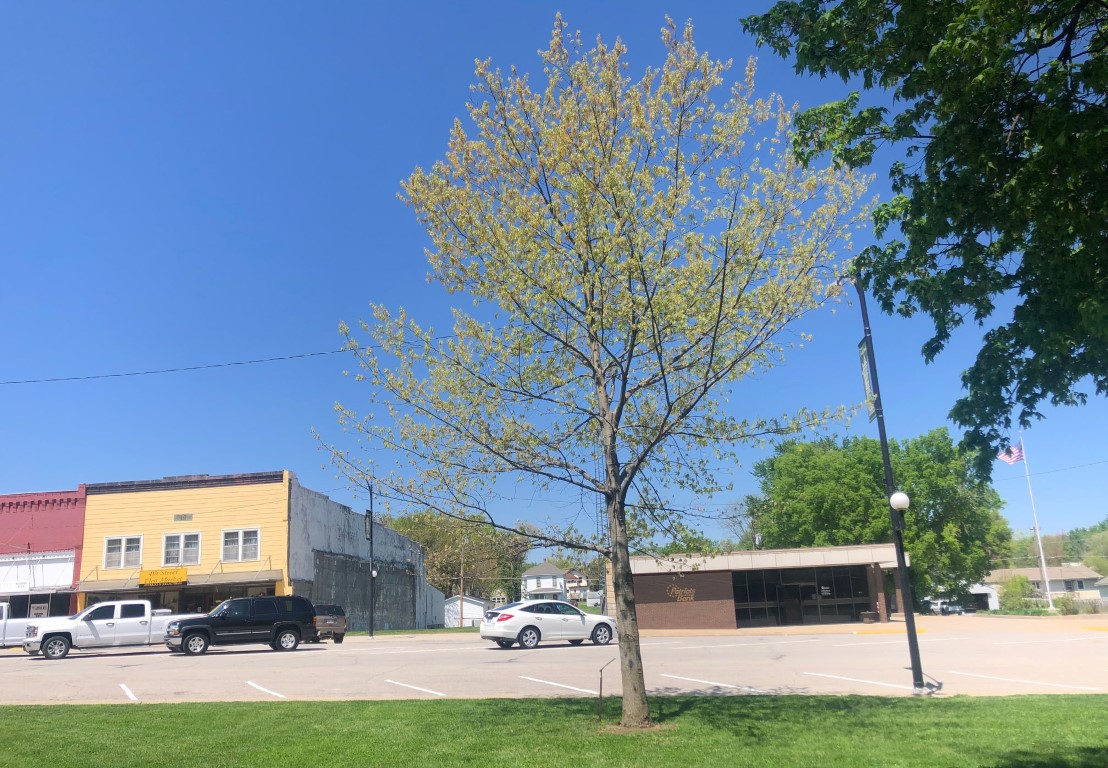
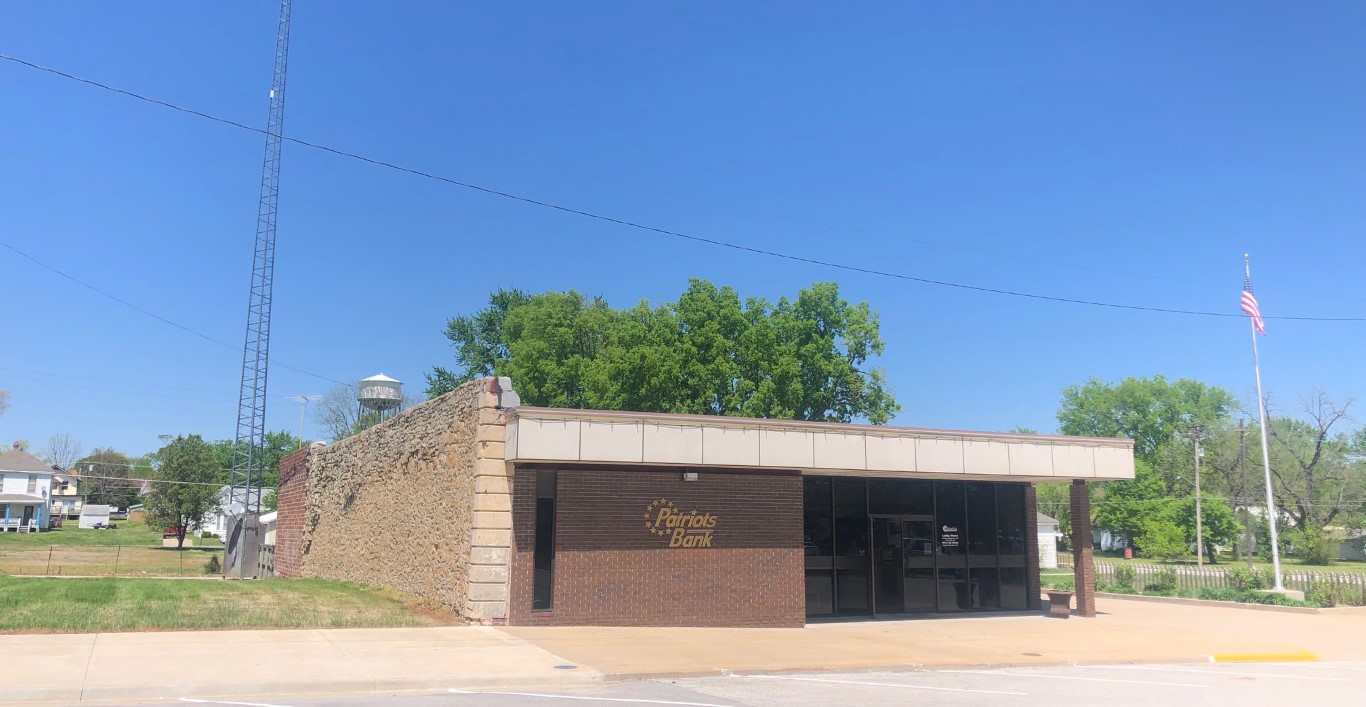
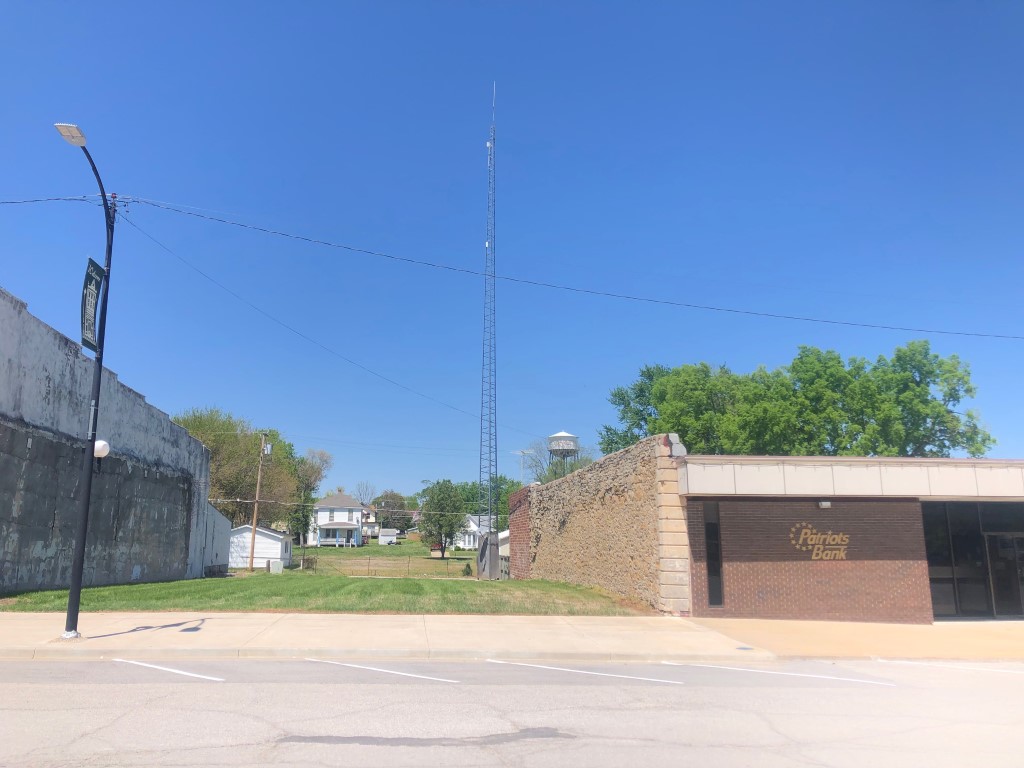
1 Sandford, Christopher. 2011. Masters of Mystery: The Strange Friendship of Arthur Conan Doyle and Harry.
2 Rhoads, Jane Glotfelty. 1855 - 1925. Kansas Opera Houses: Actors & Community Events.
3 Polidoro, Massimo. 2001. Final Séance: The Strange Friendship Between Houdini and Conan Doyle
4 Lalush, William. 2006. The Secret Life of Houdini: The Making of America's First Superhero.